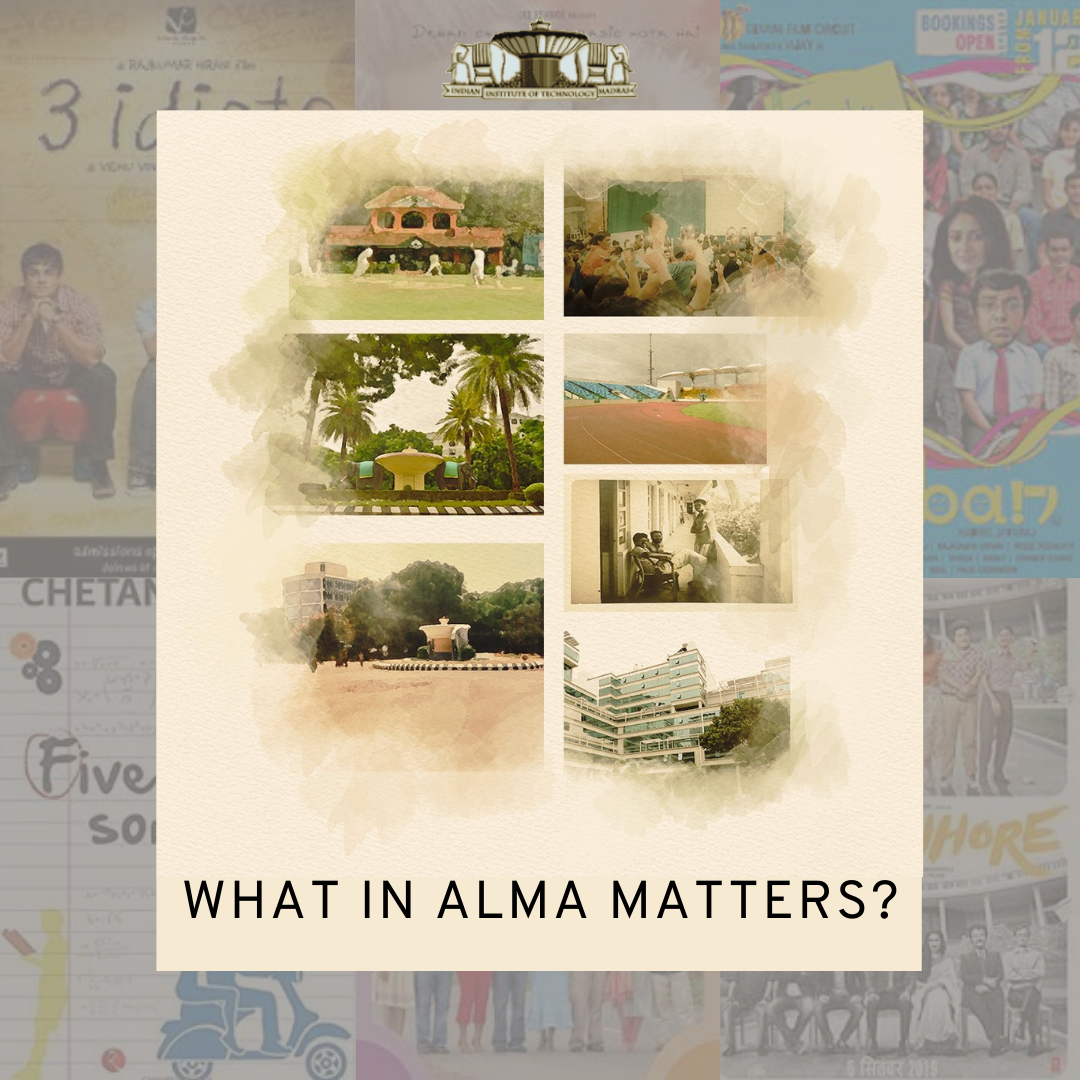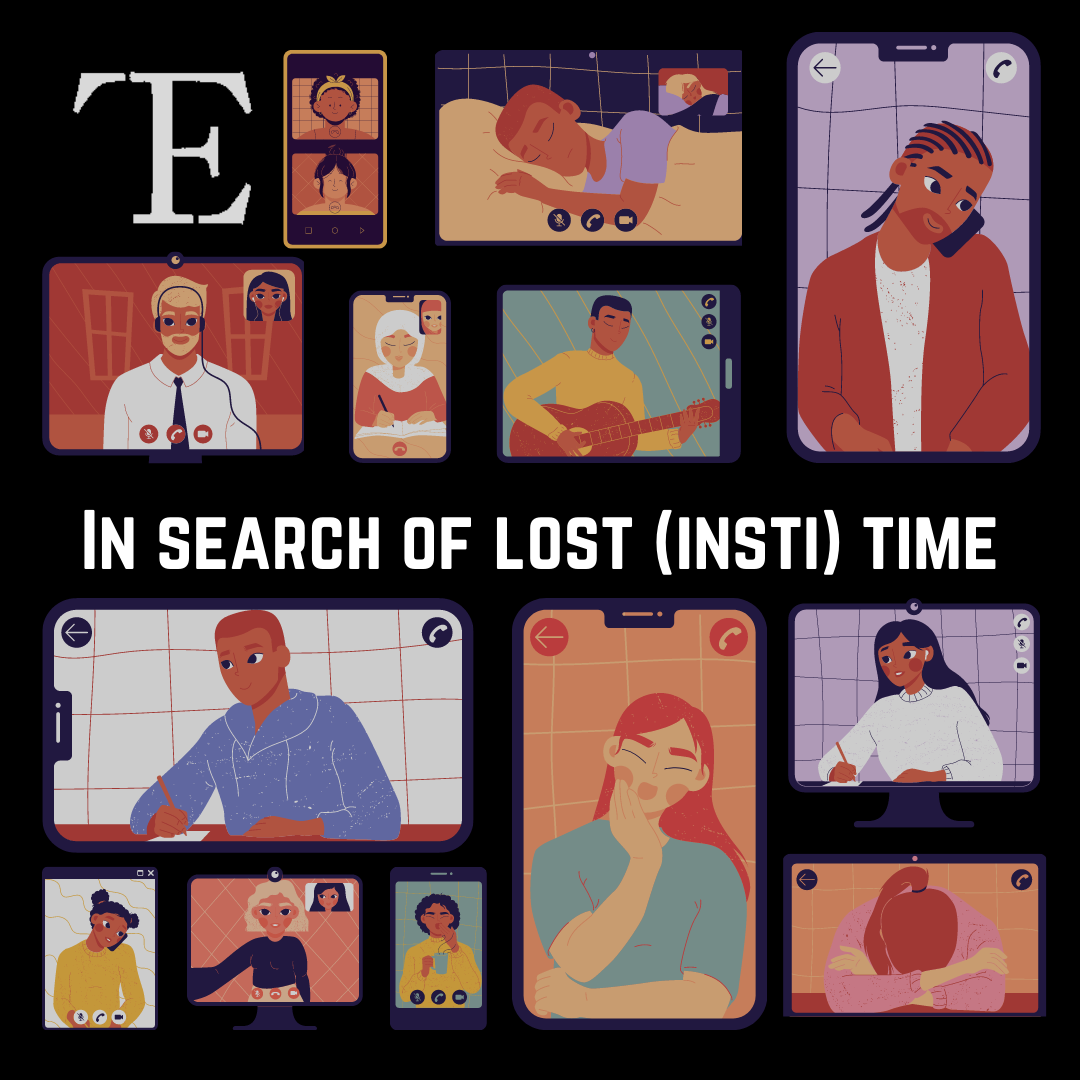Edited by Neha Cherian
Design by Bhushanraaj Sankar Kutte
As the first few shots reeled in, I was reminded of the Saarang Proshows. The lights were bright, the cheers loud and the teeming masses of students were more than a motley collection of disembodied voices and profile pictures. One could imagine that it felt surreal. And indeed, it is the dreamlike mystique of the IITs that Prashant Raj and Pratik Patra attempt to demystify in their documentary Alma Matters: Inside the IIT Dream. A neat piece of film-making, the three-part documentary invites us to wend our way through the verdant campus of IIT Kharagpur and contemplate various aspects of the IIT dream.
Towards the beginning of the documentary, a student sits by a picturesque lake with a cup of chai and recalls his disappointment on encountering the unimpressive gate of IITKGP. The struggle to reconcile astronomical expectations with reality and make peace with oneself was a recurring theme in the documentary. The first episode swiftly punctures the myth that having cleared JEE, you are sorted for life. After the symptoms of freshie-hood subside, the realisation that the department you wandered into, perhaps because of that stupidly important brain fade moment in JEE Advanced when you miscalculated the square of twelve, is absolutely not for you.
And there, in the arbitrariness of branch allotment, begins the detachment from their disciplines that a considerable number of students feel.
Alma Matters’ view of academics is underwritten by a deep cynicism for the absurd disjunction between what students want, what the market tells them to want, what JoSAA allots them and what they do, or rather, do not do with the knowledge acquired after a few years at the academic grindstone. Biswa Kalyan Rath’s half-jocular reference to the categorisation of students’ personalities based on their CGPAs- academically indifferent or eccentric chaggis, the slightly more persevering satthis, the respectable atthis and the muggu nehlis – is a sardonic reminder that the competition does not end with JEE.
The impulse to sift students through the sieve of numbers is difficult to overcome.
One would, however, be justified in thinking that the single scene with the racecar barely indicates the genuine and absorbing enthusiasm for science, innovation and engineering that are equally a part of the IITs.
The second episode is devoted entirely to placement season- the ultimate reckoning for all the good and bad karma accumulated over four years. The inordinate amount of time spent on this theme, however, risks misrepresenting it as the totalising experience of an insti student. The episode does a remarkably sensitive job of distilling the hideous anxiety of placements and duly admonishes the media for creating unreal expectations among prospective students and parents. The testimonials of a few professors and students, who bemoaned the decline of attractive core sector jobs and the attendant competition for the same, betray a larger malaise in engineering education. As one professor astutely points out, the torment of placements lies in the tragedy of students having to reinvent themselves for a corner of the market towards which everyone is gravitating. One can find grim humour in the scenes of corporate hopefuls wryly memorising fictions about their all-absorbing interest in data science and coding for their interviews. The camera cuts from boards that speak of the institute’s’ role in nation-building to students joking about having three CVs (for corporate consultancy, data and finance)- a reminder of the national aspirations that are projected onto the IITs and perhaps a comment on the erosion of this idealism.
The third episode Oxidation and Reduction is, compared to the uniform bleakness of its predecessor, a more thoughtful account of the years a student spends in insti.
The disillusionment with acads and prospects is tempered by the extraordinary energy and passion directed towards the cultural sphere and inter-hostel rivalry.
Here too one can detect the famed competitiveness of insti students, which makes it possible to execute magnificent projects like the Diwali ‘illu.’ While the genuine enthusiasm of hostellers pegging away at the illu frame was debatable, one could empathise with the students working on larger-than-life rangolis because the documentary captured the quiet contentment of doing work that is gratifying in itself.
Alma Matters treads lightly over such issues as the skewed sex ratio, mental health and student suicides, declining to engage with fraught issue of caste. Little is shown of the already outnumbered girls, besides a few shots on the sports field. The documentary’s treatment of the girl who successfully contested the elections for Sports General Secretary is emotive and her difficulties elicit appropriate outrage. However, this instance is not particularly instructive because it fails to capture or diagnose the pervasive sexism that is endemic to IITs. Alma Matters dedicates a fair bit of time to deploring the tragedy of student suicides, while adding very little to the general diagnosis of academic pressure and toxic competition.
The documentary is not a goldmine of never-heard-before truths about the IITs, nor is it the last word on student life in insti. However, it acquits itself with some credit in looking beyond the aura of the institution to find real students in all the messiness of their lives. Alma Matters is undoubtedly an inside job- there is a fond familiarity in the way the drone shots and camerawork capture the serenity of the island-like campus and the little details of student life like the homemade snacks on the shelf or the well-loved hostel pets. For a student of insti, starved for anything (besides acads) that smacks of insti feels, the IITKGP of Alma Matters is simultaneously foreign and familiar. The hostels are relatably cramped and messy, the camaraderie and cussing expected. You find yourself momentarily taken aback by the doors flung wide open, only to remember that surviving monkey-induced trauma is not a degree requirement for everyone. The large lecture halls and ubiquitous cycles, budget eateries and wooded roads and especially the solitary Mallu student – they are at once too little of insti to be satisfied with and too much to experience vicariously.




